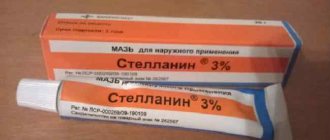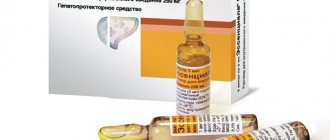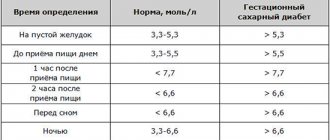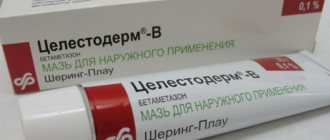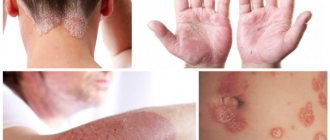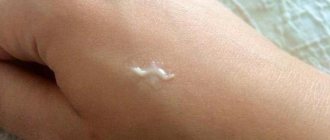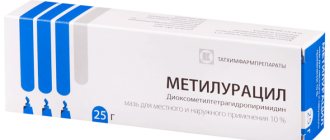Stellanin ointment contains components with antimicrobial and anti-inflammatory properties. The drug improves skin regeneration processes, which leads to rapid restoration of damaged tissue. Instructions for use of the ointment indicate the possibility of its use both for the treatment of minor scratches and for the healing of extensive bedsores and ulcers . In practical surgery, in addition to Stellanin, the ointment Stellaninpeg 3 20.0, which is similar in properties and medicinal base, is used.
Stellanin ointment
Together with the Russian Academy of Sciences and the Russian Medical Academy, scientists at Pharmpreparat LLC worked to create a new approach for the treatment of complex wounds. They obtained a formula for Stellanin-containing ointments that are capable of enabling the self-healing functions of cells at the gene level. This drug is especially valuable for people with weak regeneration processes: patients who have undergone complex operations, the elderly and bedridden patients.
Compound
Instructions for use indicate the composition of the drug:
| Substance name | Properties |
| 1,3-diethylbenzimidazolium triiodide (1 g of the drug contains 0.03 g of the component) | Has high regenerating and antiseptic activity |
| Glycerol | Prevents the drug from drying out quickly, has a disinfecting, softening effect |
| Petrolatum | Stops the inflammatory process, protects the skin from irritants |
| Polyvinylpyrrolidone | Binds all components of Stellanin ointment, increases the disinfecting properties of the medicine |
| Dimexide | Improves the penetration of drugs through tissues |
Pharmacological action of the drug
The mechanism of action of Stellanin is based on the gradual release of active iodine, which is part of the diethylbenzimidazolium triiodide molecules. When interacting with enzymes of microbial proteins, it forms clots of iodamines, due to which the death of pathogenic microbes occurs. Diethylbenzimidazolium triiodide stops the infectious process, while protecting against new infections, and promotes rapid wound healing. The main component promotes rapid cell renewal of damaged tissues, resulting in skin healing.
Indications for use
Due to its antibacterial ability and active stimulation of skin regeneration, Stellanin has a wide range of applications. This drug is used to treat:
- bedsores;
- trophic ulcers;
- dermatitis;
- eczema;
- hemorrhoids;
- 1st and 2nd degree burns;
- boils, purulent abscesses;
- abrasions, skin cracks;
- acne from insect bites.
Therapeutic properties
Stellanin ointment (reviews and effectiveness are related to the combined composition of the drug) has the following effect on the body:
- Diethylbenzimidazolium triiodite – contains iodine, which in turn has properties to kill bacteria. It also has a calming effect, improves tissue elasticity, and normalizes the water balance of the skin. Eliminates infectious processes in affected tissue areas.
- Polyvinylpyrrolidone is an assistant in cleaning the affected surface.
- Ethylene glycol polymer helps the active components of the ointment to be absorbed into body tissues more quickly. Thus, it promotes faster recovery.
Stellanin ointment - instructions for use
The course of treatment with Stellanin depends on the complexity of the affected area. Reviews from patients indicate a significant improvement in the condition of wounds within a few days. The average duration of treatment for postoperative wounds is 5-15 days. Dressings should be changed 1-2 times a day. Stellanin ointment has a maximum allowable dose per day - no more than 10 g. Depending on the area of the affected area of the body, choose an acceptable method of application:
- For healing wounds and burns, apply evenly in a layer of 1.5 mm so as to completely cover the surface of the wound, without protruding beyond the circumference of the diseased area by more than 3-5 mm. A sterile bandage is applied on top and secured with a bandage. To treat open burns, do not apply a bandage.
- For hemorrhoids, a small gauze swab is soaked in the drug and inserted into the anus.
- Deep purulent wounds are pre-treated with alcohol and filled with gauze pads containing Stellanin.
- Minor cuts and insect bites are lubricated to treat cracks 2 times a day, covering the treated area with an adhesive plaster.
Instructions for medical use of the drug Stellanin®
Registration number: LSR-000269/09 dated January 19, 2009
Trade name: Stellanin®
Chemical name: 1,3-diethylbenzimidazolium triiodide
Dosage form: Ointment for external use
Composition in 100 g of ointment: Active substance: 1,3-diethylbenzimidazolium triiodide - 3.0 g Excipients: povidone (low molecular weight polyvinylpyrrolidone), dimexide, glycerol (glycerin), petroleum jelly
Description: Dark brown ointment with a weak characteristic odor
Pharmacotherapeutic group: Tissue regeneration stimulator
ATX code : D08AC
Pharmacological properties: Pharmacodynamics The active component of the drug Stellanin® is 1,3-diethylbenzimidazolium triiodide. The mechanism of pharmacological activity of the drug lies in the direct regenerative effect of 1,3-diethylbenzimidazolium on damaged skin. Active iodine, which is part of the drug, inactivates bacterial wall proteins and bacterial enzyme proteins, thereby exerting a bactericidal effect. Stellanin protects the surface of the wound from infections, suppresses the course of the infectious process and promotes healing.
Pharmacokinetics Systemic absorption of the active substance is absent even with damaged skin, however, therapeutic concentrations of the drug are present in the wound.
Indications for use:
- trophic ulcers of the lower extremities;
- bedsores;
- burns of I and II degrees;
- abrasions, cuts, scratches, cracks, scratches, including after insect bites;
- additional treatment of aseptic postoperative wounds (after excision, coagulation, episiotomy, for the treatment of skin cracks, wounds and sutures);
- acceleration of skin graft engraftment.
Contraindications: Hypersensitivity to the components of the drug, thyrotoxicosis, thyroid adenoma, renal failure, simultaneous therapy with radioactive iodine, children under 18 years of age, first trimester of pregnancy.
With caution: Chronic renal failure, II and III trimesters of pregnancy, lactation period.
Directions for use and dosage: Externally. The drug is applied to the damaged skin surface so that the skin area is completely covered with the drug. The duration and frequency of application of the drug depends on the severity of the disease and the location of the process. The daily dose should not exceed 10 g. It is possible to use occlusive dressings and patches. When treating granulating burns, wounds and trophic ulcers with weak exudation, the drug is applied in a uniform layer 1.0-1.5 mm thick so that the entire affected surface is covered with ointment, and a sterile gauze bandage is applied. Dressings are changed once every 1-2 days when treating burns and 1-2 times a day when treating wounds and trophic ulcers. With the open method of treating burns, the drug is applied 1-2 times a day. The duration of treatment is determined by the dynamics of wound epithelization. For minor skin damage (abrasions, cuts, scratches, cracks, scratches), the drug is applied in a thin layer to the affected surface 2 times a day.
Side effects: In rare cases, allergic skin reactions (itching, skin flushing) are possible, if they occur, you should stop using the drug.
Overdose: Cases of overdose have not been described. If the drug is accidentally taken orally, nausea and vomiting may occur. It is necessary to rinse the stomach and consult a doctor; if necessary, carry out symptomatic treatment.
Interaction with other drugs: The drug should not be used in combination with other antiseptics containing mercury, oxidizing agents, alkalis and cationic surfactants. In the presence of blood, the bactericidal effect of the drug may decrease.
Special instructions: The ointment should not be applied to mucous membranes. If the drug gets into the eyes or mucous membrane, rinse with warm water.
Release form: Ointment for external use 3%. 20 g in aluminum tubes along with instructions for use in cardboard packs.
Storage conditions: In a dry place, protected from light, at a temperature of 0-25 ° C. Keep out of the reach of children.
Shelf life: 2 years. Do not use after the expiration date stated on the packaging.
Conditions for dispensing from pharmacies: Without a prescription.
Manufacturer/Enterprise accepting quality claims: Pharmpreparat LLC 346780 Russian Federation, Rostov region, Azov, st. Kalinina, 2 Tel./fax: (86342) 5-26-39
special instructions
If Stellanin ointment is applied to a bleeding wound, its activity weakens. Before using the drug to treat skin or muscle injuries, the bleeding must be stopped. If the drug accidentally gets on the mucous membranes of the body, you should immediately rinse them with water. The drug cannot be used in combination with other drugs with a bactericidal effect, which include:
- mercury;
- oxidizing agents;
- alkalis.
Contraindications
Like any pharmacological drug, this ointment has limitations for use:
- manifestation of allergic reactions to the components of the drug;
- hyperthyroidism;
- benign tumor in the thyroid gland;
- partial or complete loss of urine formation and excretion by the kidneys;
- radioiodine therapy;
- children under 18 years of age;
- first 14 weeks of pregnancy;
- chronic process of death of kidney tissue.
Side effects
Stellanin drops in rare cases lead to sleep disturbances. Cases of tachycardia in a patient who used them are described. Side effects of stellanin ointment include itching and redness of the skin. If a person is susceptible to allergies, before using the medicine it is necessary to test it - apply the ointment to a small damaged area of skin (take drops once) and carefully observe the body's reaction. If side effects occur, you should discard Stellanin and select its analogue for treatment.
Indications for use
Stellanin ointment has the following indications for external use:
- A person has chronic hemorrhoids, dermatitis, bedsores or trophic ulcers.
- Boils and cysts formed on the skin.
- The person received a first or second degree burn.
- An open wound has formed on the surface of the skin.
- The skin was bitten by an insect: a pimple or abscess appeared at the site of the bite.
Stellanin ointment for chronic hemorrhoids disinfects the skin in the damaged area and stimulates its healing.
Analogue ointment Stellanin
You should choose an analogue of stellanine ointment if any component included in the drug causes an allergic reaction. The molecular formula of the substance has no analogues yet. Clinical trials and reviews from patients who have used it confirm the more effective regenerating effect of this medicine. Among the analogues of Stellanin ointment are:
- Bepanten. This ointment is based on dexpanthenol and has an antiseptic effect. Use for minor skin damage.
- Betadine stops inflammatory processes and has regenerative properties. The active ingredient is iodine.
- Iodopyrone. Effective in the treatment of postoperative, purulent wounds, boils.
Reviews
Olga, Zvenigorod
My grandmother suffered a stroke six months ago and has not left her bed since then. Naturally, despite good care, bedsores appeared on the buttocks. We tried many different ointments and settled on Stellanin. This ointment eliminates redness in just a few days, so we have so far managed to prevent the appearance of extensive wounds.
Marina, 50 years old, St. Petersburg, used Stellanin-Peg in the form of an ointment to treat a boil on the neck. The drug helped quickly draw out the pus, but the process of skin restoration was delayed. The wound healed completely only after two weeks, I don’t know whether this is due to the ointment or other reasons.
Stellanina price
The cost of Stellanin ointment varies significantly within Moscow. The table shows the price of Stellanin in rubles:
| Pharmacy | Price | Address |
| Chain of pharmacies "Dialogue" | 368 | |
| Health emphasis | 375 | st. Pervomaiskaya, 74 |
| Aster | 393 | st. Avangardnaya, 12 |
| Economy in Khovrino | 397 | Petrozavodskaya st., 9, building 2 |
| Good Pharmacy | 401 | st. Nizhegorodskaya, 71 |
| Terra Vita | 412 | Nagatinskaya emb., 16, building 3 |
| Honest pharmacy | 430 | st. Dolgorukovskaya, 38, building 1 |
| Sun | 475 | st. Novozavodskaya, 2, building 1 |
| Altechcom | 495 | Shipilovsky proezd, 39, building 1 |
| Vivafarm | 541 | st. Novokosinskaya, 19 |
| Eco World | 629 | st. Marshala Katukova, 24, building 5 |
Drug overdose
Stellanin ointment (reviews and effectiveness of this drug does not describe cases of overdose) if penetrated into the stomach or if used uncontrolled for a long time, can cause harm , since from a scientific point of view, each person has an individual perception of any medicinal substance.
Exceeding the permissible dose of the drug manifests itself as retching, vomiting, dizziness, inflammation of the oral cavity and esophagus, and sudden acute heart failure.
Selection and purchase of ointment
Before purchasing the drug, you must clarify the diagnosis with your doctor.
Levomekol has a quick therapeutic result for similar symptoms. It also disinfects, relieves inflammation, and promotes tissue regeneration.
So which is better, Stellanin PEG ointment or Levomekol? These are not analogues of each other, they have different compositions. The first has a wider spectrum of action (bacteria, fungi, viruses), but it has many contraindications.
Only a doctor can recommend a particular medication, taking into account the problem that has arisen.
Analogs
Reviews about the medication are mostly positive, but buyers note the high price. Therefore, you can replace Stellanin with cheap analogues.
For bacterial and fungal infections, Betadine is used, it costs from 180 rubles.
Panthenol is prescribed if a patient is allergic to iodine, costs from 130 rubles.
Zinc will help with cuts and has a drying effect. It has virtually no contraindications. Cost in pharmacies from 30 rubles.
For wounds with purulent discharge, Iodopirone ointment is used. Price starts from 60 rubles, but is difficult to find in pharmacies.
Drugs with a similar spectrum of action
The composition of Stellanin ointment has no analogues. This is the best domestic remedy, which simultaneously has wound-healing, antiseptic and bactericidal properties. If for some reason this medication cannot be purchased and used to treat skin pathologies, it can be replaced with other drugs of a similar spectrum of action, the cheapest and most effective of which are presented in the following table:
| Drug name | Active substance | Manufacturer | Price |
| Betadine | Povidone-iodine 100 mg | Egis (Hungary) | from 150 to 300 rub. |
| Iodopyridone solution | Povidone-iodine | YUZHFARM | from 69 to 200 rub. |
| Yod-ka | Povidone-iodine | AMT TRADE | from 15 to 150 rub. |
| Bepanten | Dexpanthenol | Bayer | from 300 to 700 rub. |
| Levomekol | Dioxomethyltetrahydropyrimidine + Chloramphenicol | NIZHFARM | from 125 to 250 rub. |
| D-Panthenol | Dexpanthenol + Chlorhexidine | NIZHFARM | from 150 to 250 rub. |
| Zinc ointment | Zinc oxide | OJSC "Tver Pharmaceutical Company" | from 30 to 60 rub. |
The cost of medicines in different pharmacies may differ depending on the region, which is due to different conditions of cooperation with manufacturers and delivery of goods.
Betadine, Iodopyridone and Bepanthen
Let's take a closer look at each analogue:
- Betadine
is an antibacterial, antifungal ointment, which is a cheap analogue of Stellanin. It is prescribed for the development of trophic ulcerative lesions on the legs, burns of the first two degrees of severity, as well as for the development of fungal and bacterial infections in wounds. - Iodopyridone solution
has powerful antiseptic and antibacterial properties. Its difference from Stellanin is its low cost and active ingredient. Using the solution to irrigate the throat during pain may cause a feeling of dryness, which is not critical. As an antiseptic, this is the best cheap remedy after Stellanin. - Bepanten
is used for the prevention and treatment of dry skin when its integrity is damaged in newborns and nursing mothers. The medication activates the process of cell regeneration in case of small cracks in the skin, mild burns, abrasions, irritations, ulcerative lesions, and also after skin transplantation. Used for the prevention and treatment of bedsores.
Levomekol and other analogues
Levomekol is a combined-spectrum drug with antimicrobial and anti-inflammatory properties. Used to treat purulent wounds and burns. The difference in the pharmacological action of this ointment from Stellanin is that in the presence of pus and necrotic elements in the wound, the antibacterial effect of the drug remains unchanged.
Zinc ointment is a drug that has an adsorbing, drying and antiseptic effect. If you have acute intolerance to Stellanin, it is better to use this medicine for the treatment of diaper rash, pimples, cuts and wounds on the skin, since it has no contraindications at all.
Iodine is a solution for local and external use that has antiseptic properties.
D-Panthenol - used to accelerate cell regeneration processes in case of skin wounds, treatment of diaper rash, burns, bedsores, abrasions, scratches, as well as trophic ulcerative lesions. Experts recommend using the drug for healing and preventing infection of damaged areas of the epidermis.
Doctors recommend using Stellanin analogues only in cases of individual intolerance to the drug, with strict adherence to the treatment regimen described in the annotation for the selected product. If there is no positive dynamics in the treatment of lesions on the skin, you should stop using the analogue and consult a dermatologist.
Storage conditions and drug interactions
The use of the drug from the first day of the appearance of damage to the upper layer of the epidermis causes the fastest possible restoration of the structure and appearance of the skin, prevents the appearance of scars, burns and cicatrices. As a result of treatment, the skin becomes clean and beautiful, as before it was damaged.
The daily dosage of the composition should not be more than 10 grams. Increasing the dosage is possible only after consultation with a specialist in case of a complex course of the dermatological disease. The drug should be stored in a cool place, protected from direct sunlight, for example in a refrigerator door. Shelf life is no more than 2 years. Keep away from children.
Please note that after the expiration date indicated on the packaging, the drug must be disposed of.
The drug is not prescribed with medications containing components such as mercury, cationic components and oxidizing agents. The parallel use of Stellanin with alkaline-based medications is excluded.
For hemorrhoids
The medicinal drug has a positive effect on hemorrhoids and hemorrhoids, as this is an inflammatory process. This drug has proven itself very well for this disease. When treating hemorrhoids, you need to make a tampon from a rough cloth or gauze, which must be soaked or well smeared with Stellanin ointment.
The resulting tampon must be inserted into the rectum, to the depth of manifestation of the disease. The duration of treatment should be continued for up to 2 weeks, inserting a tampon with ointment in the morning and evening. The advantages of this ointment in the treatment of hemorrhoids are that in mild forms of the disease it is enough to use the medicine for several days, and in more severe cases - more than 2 weeks.
For herpes
Stellanin ointment (reviews and the effectiveness of this drug prove that it is a very good and effective remedy) is used in the fight against the incipient process and repeated manifestations of herpetic viral infection.
Stellanin ointment is used to treat herpes on the lips.
Since this pathology is provoked by a virus that lives in a person’s blood, the ointment will not kill him, but Stellanin can handle visible manifestations. At the first signs of skin manifestations of herpes, and this is itchy irritation on the lips (sometimes subfibrillation), it is necessary to begin treatment.
At the first symptoms, a small amount of the product should be applied to the skin manifestations of the disease several times a day. This action can stop the development of the process, since the virus spreads on the skin very quickly. The duration of therapy is until all signs of skin manifestations of herpes completely disappear.
For acne
Stellanin ointment is an effective remedy in the fight against acne, not only judging by the reviews of patients, it has also proven its effectiveness in clinical trials. This medicine copes well with the inflammatory process.
The use of the drug Stellanin helps prevent infection and intensification of the inflammatory process in existing acne.
If there is a small amount of acne, you need to apply a little product to the acne, cover it with a napkin and fix it with a medical plaster. In case of a large number of acne, the ointment should be applied to the face (leaving the area around the eyes untouched) in a thin layer.
Treatment should be done in the evening before bedtime. In the morning, any remaining medication should be washed off with water. The duration of therapy must be continued until the acne disappears completely.
